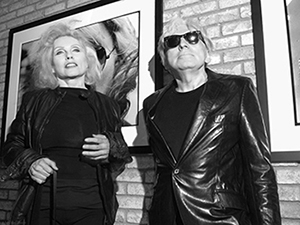Deborah Harry & Chris Stein, with Anthony DeCurtis, 92 Y, NYC, 5.28.14
by Michael Sherer
Posted: Jul 2014
(3166) Page Views

Deborah Harry & Chris Stein - photo by Michael Sherer
As the band Blondie is in its 40th anniversary, its co-founders Deborah Harry and Chris Stein sat down with journalist Anthony DeCurtis for a conversation at the fabled 92 Y. Harry came out with black tape over her mouth, which got some laughs. Stein asked her if it meant that she wouldn’t be talking, and Harry in turn removed the tape and said that didn’t, and that she was just blotting her lipstick with it.
Harry, 68, was rather reserved throughout, with Stein being the more talkative of the two. Stein, 64, has been photographing since ‘68, and is a graduate of the School of Visual Arts in lower Manhattan as a photography major. Stein has spent much time putting together a forthcoming photography book that has lots of photos of Harry and the band from their earliest days. There was good deal of discussion on the book, which I enjoyed. Being a photographer myself, this was the most interesting part of discussion for me. It became more so when many images from the book were shown on the screen. Some were really quite good.
DeCurtis, who has a very kind and humble disposition, posed interesting questions to the duo, which spanned from their early years through the present. The process of making their new CD, Ghosts Of The Download, was discussed, as was their new 40th anniversary compilation CD, called Blondie 4(0)-Ever, with some hit songs newly rerecorded. Redoing vintage songs is often a contentious subject for fans, who often feel they should be left alone. On the other hand, some enjoy hearing how the band/artist sound doing them again, decades later in this case. Harry spoke of how interesting it was to redo them, saying that it brought back many memories, and was like seeing a film as flashes of experiences that occurred the first time flashed back to her.
DeCurtis held up the cover of the vinyl version of Blondie 4(0)-Ever, which features a painting of Harry’s face done by Andy Warhol in the late ‘70’s. It was one of the key things that raised Harry’s profile, literally and figuratively, to a much higher level in the public consciousness. DeCurtis asked Harry what the experience was like with Warhol, and she replied that he was great work with, that he didn’t say a lot, and that Chris took some interesting photos of Warhol photographing Harry. (To be found in Stein’s photography boo, I surmise.)
The question of what musical and cultural influences shaped Harry and Stein was also posed. Stein answered first, saying that his first musical love was film scores, such as Mancini. He said that the film West Side Story kicked off his affair with the genre, and noted how much of a huge cultural deal it was, mainly to the youth of his generation, when it was released in ‘61. Stein said that his next love was folk music, especially Bob Dylan, and then rock and popular music, particularly the Beatles, whom he thought “sounded corny for the first five minutes”, but then got increasingly drawn into.
Harry said that she was a like a sponge in absorbing a wide variety of styles, mainly via a small transistor radio that she had, which picked up radio stations from Newark, New Jersey from her suburban home in Hawthorne, Jersey. The girl groups of the ‘60’s, and the Phil Spector Wall Of Sound certainly were amongst Harry’s most influential discoveries.
An important topic of discussion was how Manhattan has changed radically since Blondie’s formation, and before that when they were teenagers. It was during their teenage years that Stein would venture to the West Village, especially Washington Square Park, from his native Brooklyn, and Harry from Jersey, where she was raised by protective, adoptive parents. A great deal of the the duo’s aesthetic was shaped by the Village scene of Manhattan. Both Harry and Stein are arty, bohemian types at heart, hallmarks of the Village, and its ethos was ideally suited to them.
With the late Hilly Kristal starting the small rock club CBGB in ‘74 on the Lower East Side’s Bowery, and with many other downtown clubs offering what was then a nascent punk and new wave movement, all the young, new bands such as Blondie had a very strong collective to be a part of, rendering it a proverbial “scene.” CBGB and the older Max’s Kansas City on Park Ave South at 17th Street were by far the most important. The scene culminated in ‘76, when a tangible and sonic onslaught was produced, via a live, double record album put out by Atlantic Records. It was called “Live At CBGB’s,” and featured some of the bands that regularly performed at CBGB. (But not Blondie, surprisingly.) It was Sire Records head Seymour Stein that was the most attuned and receptive to the scene in general, though, and, for examples, The Ramones, Talking Heads and later Madonna were on his label.
Over the many years since this period, it’s become vastly more expensive to live downtown, and the wide variety and cross breeding of styles, ideas and activity has mostly dried up. Both Harry and Stein lament that, and spoke of the need for an infusion of new ideas and pollination to bring any life back to it, although it would still be prohibitively expensive to reside there. This was the most important and universal subject that was raised throughout the evening in my view, as it certainly applies to many pockets of cities throughout the world.
Hopefully, it was something more for the audience to ponder as they left into the very non-downtown-like Upper East Side night.